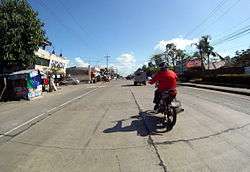Ramon, Isabela
Ramon, officially the Municipality of Ramon (Ilocano: Ili ti Ramon; Tagalog: Bayan ng Ramon), is a 2nd class municipality in the province of Isabela, Philippines. According to the 2015 census, it has a population of 52,707 people.[3]
Ramon | |
|---|---|
| Municipality of Ramon | |
 | |
 Seal | |
| Nickname(s): Tilapia Capital of Isabela Hub of Magat Dam | |
| Motto(s): Aramid ti pakakitaan | |
 Map of Isabela with Ramon highlighted | |
OpenStreetMap 
| |
.svg.png) Ramon Location within the Philippines | |
| Coordinates: 16°47′N 121°32′E | |
| Country | |
| Region | Cagayan Valley (Region II) |
| Province | Isabela |
| District | 3rd District of Isabela |
| Established | January 1, 1964 |
| Barangays | 19 (see Barangays) |
| Government | |
| • Type | Sangguniang Bayan |
| • Mayor | Jesus D. Laddaran |
| • Vice Mayor | Nestor O. Banhan |
| • Congressman | Ian Paul L. Dy |
| • Electorate | 33,436 voters (2019) |
| Area | |
| • Total | 135.17 km2 (52.19 sq mi) |
| Population (2015 census)[3] | |
| • Total | 52,707 |
| • Density | 390/km2 (1,000/sq mi) |
| • Households | 13,040 |
| Economy | |
| • Income class | 2nd municipal income class |
| • Poverty incidence | 13.39% (2015)[4] |
| • Revenue (₱) | 155,061,257.33 (2016) |
| Time zone | UTC+8 (PST) |
| ZIP code | 3319 |
| PSGC | |
| IDD : area code | +63 (0)78 |
| Climate type | tropical rainforest climate |
| Native languages | Ilocano Tagalog |
| Website | www |
The municipality of Ramon has a semi-radial but more defined linear development along the national road from Santiago City in the south to San Mateo towards the north. With the completion of the Magat River Multi-purpose high dam at Barangay General Aguinaldo, near the Isabela-Ifugao provincial boundary, trend of expansion has deviated westward.
History
In the middle of nowhere (1925-2016) when the San Jose–Santa Fe national road opened, Ilocano migrants from the Central Plain of Luzon like Tarlac, Pangasinan, and Nueva Ecija, arrived in bull carts to settle on this vast area covered with weeds called “samon” as homesteaders. As required by statutes, these people stayed right on their 24 hectares (59 acres) farms to clear the lot in order call it their own. The place was a part of Buenavista, the oldest barrio of Santiago, Isabela. For more than ten long years amidst hardships and sufferings due to malaria disease and unfavorable weather conditions, the pioneers labored to convert their homestead into a productive farm with palay as their main crop.
At the latter part of the thirties (1937), the Santiago–Santa Maria road via Mallig Plains was opened and more immigrants came to farm in the place. This area which is 10 kilometres (6.2 mi) away from the town proper of Santiago later emerged to become barrio Bugallon, eventually becoming the biggest barrio of Santiago.
The completion of the Maris Dam at Oscariz in 1957 attracted more migrants to farm at the irrigated areas of Bugallon. Along with the Ilocano arrivals were few Tagalogs, Pangasinenses, and many others.
The municipality of Ramon was created on June 18, 1961, by virtue of Republic Act No. 3320 sponsored by the then Congressman Delfin Albano of the then lone district of Isabela. On November 12, 1963, the first set of local officials were elected with Angelino F. Vizcarra as Municipal Mayor.
The original seat of government was first conceived to be established 500 meters north of Barangay Burgos. However, the local officials decided to temporarily locate the site at Bugallon which eventually became the permanent site by virtue of Republic Act No. 11354, upon which a two storey Municipal Hall was built on December 8, 1968.
The municipality was named in honor of Don Ramon Elento and was originally classified as a seventh class municipality at the time of its inauguration on January 1, 1964. Ramon had 12 original barangays carved out from the municipalities of San Mateo and Santiago. In 1966, another barangay was annexed from the municipality of Echague. Later, by virtue of the revised Barangay Charter or Republic Act. No. 3590, six additional barangays were created.
The rural Electrification Program of ISELCO I was completed in the later part of the seventies (1976–77).
And, with the completion of the Magat High Dam in 1983, more areas were converted into irrigated rice lands which attracted more and more people from all places to migrate to the municipality, including Igorots and Ifugaos from the hinterlands.
Barangays
- Ambatali
- Bantug
- Bugallion Norte
- Bugallion Proper (Centro)
- Burgos
- General Aguinaldo
- Nagbacalan
- Oscariz
- Pabil
- Pagrang-ayan
- Planas
- Purok ni bulan
- Raniag
- San Miguel
- San Antonio
- San Sebastian
- Villa Beltran
- Villa Carmen
- Villa Marcos
Demographics
| Year | Pop. | ±% p.a. |
|---|---|---|
| 1970 | 15,211 | — |
| 1975 | 17,841 | +3.25% |
| 1980 | 30,815 | +11.55% |
| 1990 | 33,444 | +0.82% |
| 1995 | 35,885 | +1.33% |
| 2000 | 41,441 | +3.13% |
| 2007 | 45,258 | +1.22% |
| 2015 | 52,707 | +1.92% |
| Source: Philippine Statistics Authority[3][5][6][7] | ||
In the 2015 census, the population of Ramon, Isabela, was 52,707 people,[3] with a density of 390 inhabitants per square kilometre or 1,000 inhabitants per square mile.
Climate
| Climate data for Ramon, Isabela | |||||||||||||
|---|---|---|---|---|---|---|---|---|---|---|---|---|---|
| Month | Jan | Feb | Mar | Apr | May | Jun | Jul | Aug | Sep | Oct | Nov | Dec | Year |
| Average high °C (°F) | 31 (88) |
31 (88) |
32 (90) |
34 (93) |
35 (95) |
34 (93) |
32 (90) |
32 (90) |
32 (90) |
32 (90) |
32 (90) |
31 (88) |
32 (90) |
| Average low °C (°F) | 22 (72) |
22 (72) |
22 (72) |
24 (75) |
24 (75) |
24 (75) |
24 (75) |
24 (75) |
24 (75) |
23 (73) |
23 (73) |
22 (72) |
23 (74) |
| Average precipitation mm (inches) | 13.6 (0.54) |
10.4 (0.41) |
18.2 (0.72) |
15.7 (0.62) |
178.4 (7.02) |
227.9 (8.97) |
368 (14.5) |
306.6 (12.07) |
310.6 (12.23) |
215.7 (8.49) |
70.3 (2.77) |
31.1 (1.22) |
1,766.5 (69.56) |
| Average rainy days | 3 | 2 | 2 | 4 | 14 | 16 | 23 | 21 | 24 | 15 | 10 | 6 | 140 |
| Source: World Weather Online[8] | |||||||||||||
Economy
Endowed with prime agricultural lands, the majority of its inhabitants derive their income from agriculture. Ramon ranks among the top rice-producing towns of Isabela alongside the towns of Alicia and San Mateo.
The northern border of Ramon is the Magat River that provides power to national grid though the Magat Dam. The dam is a major employer in Barangay General Aguinaldo and has the works buildings and staff compounds situated there also. An undeveloped airport is in the area next to the river.
Ramon functions as a satellite town of Santiago City, a major growth center in southern Isabela. The Magat River Multi-purpose project, likewise, provides the municipality economic and social gains brought about by the influx of technological advancements like irrigation and electric power.
La Salette Heritage
Since 1948, Ramon was a mission of Santiago. It was 1978 that Ramon had a resident priest and it was only March 28, 1981 that then Bishop Miguel G. Purugganan, canonically erected this town into the status of a parish with Fr. Conrad Blanchet, MS as its first official parish priest.
Former Bishop Sergio L. Utleg, D.D., the Ordinary of the Diocese of Ilagan (now the Archbishop of the Archdiocese of Tuguegarao), offered the Parish of San Roque to remain under the "in perpetuum" care of the Missionaries of Our Lady of La Salette. The Provincial Superior, in deliberation with his Council, accepted the offer in its 94/04 decision in their meeting June 29, 2004. With this event, the Town of Ramon is now the only remaining parish entrusted to the Missionaries of Our Lady of La Salette.
References
- "Municipality". Quezon City, Philippines: Department of the Interior and Local Government. Retrieved 31 May 2013.
- "Province: Isabela". PSGC Interactive. Quezon City, Philippines: Philippine Statistics Authority. Retrieved 12 November 2016.
- Census of Population (2015). "Region II (Cagayan Valley)". Total Population by Province, City, Municipality and Barangay. PSA. Retrieved 20 June 2016.
- "PSA releases the 2015 Municipal and City Level Poverty Estimates". Quezon City, Philippines. Retrieved 1 January 2020.
- Census of Population and Housing (2010). "Region II (Cagayan Valley)". Total Population by Province, City, Municipality and Barangay. NSO. Retrieved 29 June 2016.
- Censuses of Population (1903–2007). "Region II (Cagayan Valley)". Table 1. Population Enumerated in Various Censuses by Province/Highly Urbanized City: 1903 to 2007. NSO.
- "Province of Isabela". Municipality Population Data. Local Water Utilities Administration Research Division. Retrieved 17 December 2016.
- "Ramon, Isabela: Average Temperatures and Rainfall". World Weather Online. Retrieved 31 October 2015.
External links
- Ramon Profile at PhilAtlas.com
- Municipal Profile at the National Competitiveness Council of the Philippines
- Ramon at the Isabela Government Website
- Local Governance Performance Management System
- Philippine Standard Geographic Code
- Philippine Census Information
- Municipality of Ramon
- Local Governance Performance Management System